White Bolognese with Cream
by Joshua McFadden, featured in Six Seasons of Pasta Published by Artisan BooksIntroduction
As with so many classic dishes, ragu alla Bolognese (the parent to this ragu) comes with variants, misconceptions, and many strong opinions. The primary debate is whether Bolognese sauce is a tomato sauce or not. From what I know, “not” is the most accurate answer, though outside of Italy, ragu alla Bolognese has somehow morphed into what might be called “spaghetti sauce,” a very tomatoey sauce with ground meat.
Most traditional Italian versions of ragu alla Bolognese focus on the meats, which can include a range—beef, pork, veal, prosciutto. The sauce generally includes finely ground meats and finely chopped soffritto, and the flavor is intense and luxurious. In recipes that include tomato—whether as paste, canned, or both—it is not the principal ingredient. The no-tomato version is often called white or bianco.
While I’m all for tradition, I also like to push the edges a bit, which is why this version of white Bolognese, inspired by one made by Australian food writer Odette Williams, caught my attention. Here the “white” refers to not only the absence of tomato but also to a generous addition of cream. The sauce is made even creamier by blending a portion of it and then folding it back in. I add dried porcini to the mix, intensifying the umami savoriness.
This elegant ragu is beautiful when served simply with classic long noodles such as pappardelle, tagliatelle, or fettucine. It is fantastic with handfuls of greens tossed in at the very end, especially nice bitter greens such as escarole or dandelion.
As with so many classic dishes, ragu alla Bolognese (the parent to this ragu) comes with variants, misconceptions, and many strong opinions. The primary debate is whether Bolognese sauce is a tomato sauce or not. From what I know, “not” is the most accurate answer, though outside of Italy, ragu alla Bolognese has somehow morphed into what might be called “spaghetti sauce,” a very tomatoey sauce with ground meat.
Most traditional Italian versions of ragu alla Bolognese focus on the meats, which can include a range—beef, pork, veal, prosciutto. The sauce generally includes finely ground meats and finely chopped soffritto, and the flavor is intense and luxurious. In recipes that include tomato—whether as paste, canned, or both—it is not the principal ingredient. The no-tomato version is often called white or bianco.
While I’m all for tradition, I also like to push the edges a bit, which is why this version of white Bolognese, inspired by one made by Australian food writer Odette Williams, caught my attention. Here the “white” refers to not only the absence of tomato but also to a generous addition of cream. The sauce is made even creamier by blending a portion of it and then folding it back in. I add dried porcini to the mix, intensifying the umami savoriness.
This elegant ragu is beautiful when served simply with classic long noodles such as pappardelle, tagliatelle, or fettucine. It is fantastic with handfuls of greens tossed in at the very end, especially nice bitter greens such as escarole or dandelion.
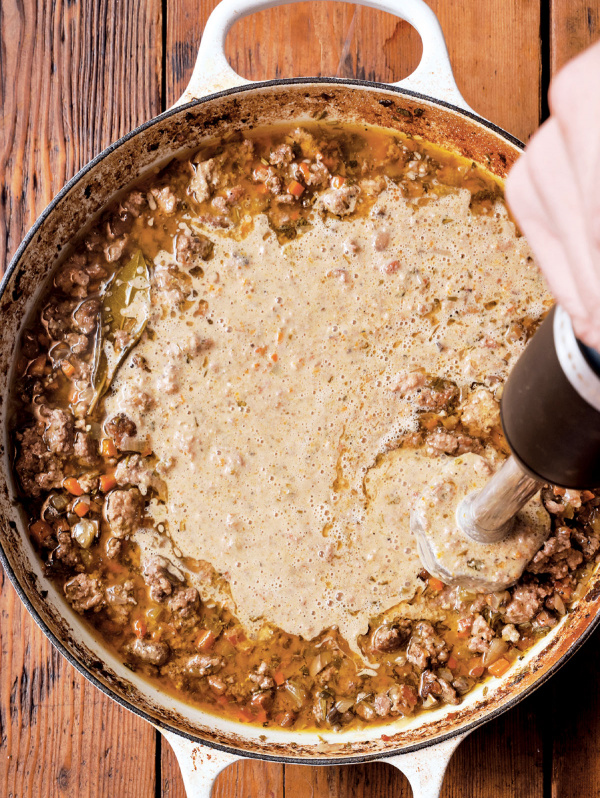
Share or save this
Ingredients
Makes: generous 6 cups (1.5 kg), enough to sauce 12 portions of pasta
- ½ ounce dried porcini mushrooms (optional)
- extra virgin olive oil
- 5 ounces pancetta (finely chopped)
- 1 pound ground beef
- 1 pound ground pork
- 4 cups finely chopped cremini mushrooms
- ⅔ cup finely diced carrots
- ⅔ cup finely diced celery
- ⅔ cup finely chopped onions
- 3 or 4 garlic cloves (finely chopped)
- 1 cup dry white wine
- 2 teaspoons finely chopped fresh rosemary
- 1 teaspoon finely chopped fresh sage
- 1 teaspoon finely chopped fresh thyme
- 2 or 3 bay leaves
- 1 quart homemade or low-sodium beef or chicken broth
- ¾ cup heavy cream
- ¼ teaspoon freshly ground black pepper
- Freshly grated nutmeg
- kosher salt
- 15 grams dried porcini mushrooms (optional)
- extra virgin olive oil
- 140 grams pancetta (finely chopped)
- 450 grams minced beef
- 450 grams minced pork
- 225 grams finely chopped chestnut mushrooms
- 85 grams finely diced carrots
- 85 grams finely diced celery
- 100 grams finely chopped onions
- 3 or 4 garlic cloves (finely chopped)
- 240 millilitres dry white wine
- 2 teaspoons finely chopped fresh rosemary
- 1 teaspoon finely chopped fresh sage
- 1 teaspoon finely chopped fresh thyme
- 2 or 3 bay leaves
- 1 litre homemade or low-sodium beef or chicken stock
- 180 millilitres double cream
- ¼ teaspoon freshly ground black pepper
- Freshly grated nutmeg
- kosher salt
Method
White Bolognese with Cream is a guest recipe by Joshua McFadden so we are not able to answer questions regarding this recipe
- Heat a glug of olive oil in a large, deep, heavy-bottomed pot, such as a Dutch oven, over medium heat. When the oil is hot, add the pancetta and cook until it is crisp and most of the fat has melted out, 5 to 6 minutes, then remove it with a slotted spoon and set it aside.
- Pour off all but about 3 tablespoons of the fat from the pan (the fat will add wonderful flavor, but you don’t want so much that the sauce becomes too heavy). Increase the heat to medium-high, add the ground beef and pork, and cook, breaking the meat up into bits with your spoon, until it’s browned on the surface and no longer pink inside, 5 to 6 minutes. Transfer the meat with a slotted spoon to a bowl and set aside.
- Add the cremini mushrooms, carrot, celery, onion, garlic, and chopped porcini, if using, and cook, stirring frequently so the moisture from the vegetables “deglazes” any cooked-on meat juices, until the vegetables are tender and most of the liquid released by the mushrooms has evaporated, 8 to 10 minutes. Don’t actually brown the vegetables but aim to get them lightly caramelized.
- Add the white wine, rosemary, sage, thyme, and bay leaves, then return all the meat to the pan and simmer until the wine has reduced almost entirely. Add the broth and simmer gently, stirring frequently, until it’s reduced by half, 1 to 1½ hours.
- Add the cream and simmer until the cream has reduced a bit and incorporated into the sauce, 4 to 5 minutes.
- Retrieve the bay leaves and discard them. Add the black pepper, several gratings of fresh nutmeg (a Microplane-style grater works well for this), and a pinch of salt.
- Scoop out about one-quarter of the sauce, transfer to a blender, and blend until it’s mostly smooth and emulsified (it will remain a bit granular). You can also use an immersion blender to puree the sauce right in the pot. Return it to the pan with the rest of the sauce and stir to combine. Taste and add more salt if you like, but remember that you’ll be adding cheese when you use this sauce to make your pasta dish.
- Let the ragu cool completely, then divide it into 1-cup (250 g) portions (enough to sauce 8 ounces/225 g dried noodles, or two servings). Use now (the ragu will last for up to 5 days in the refrigerator) or freeze for up to 4 months.
- To serve, follow the process outlined in How to Sauce Pasta with a Ragu, below.
HOW TO SAUCE PASTA WITH A RAGU
While a ladleful of red sauce cascading over a bowl filled with spaghetti may be what springs to mind when you think "ragu", that's not how saucing pasta works, at least not in my pasta reality. And thank goodness, because the proper way to sauce your pasta yields much more delicious and easy-to-eat results.
First, Italians don't drown their pastas with sauce, and neither should you. A well-made sauce has enough intensity of flavor that a small amount is adequate. And, of course, a huge part of the pleasure of pasta is, well, the pasta—the noodles themselves. You want enough ragu or other sauce to lightly coat all the noodles and to have plenty of the added ingredients per bite, but you never want a pool of sauce at the bottom of the bowl. For the ragus in this book, a 1-cup (250g) amount is enough to sauce 8 ounces (225g) of dried pasta, which is generally a perfect amount for two people.
Bringing a ragu to the perfect noodle-cloaking consistency uses pasta water, that magic ingredient that helps integrate all the components of a pasta dish—the noodles, the sauce, the cheese, and sometimes butter or olive oil. Here are the steps to make this happen:
- Get your salted pasta water boiling.
- Put a splash of the pasta water into a large skillet over medium-high heat. Add 1 cup (250g) of the ragu of your choice; if it's still frozen, allow a few extra minutes for it to thaw.
- Add 8 ounces (225g) of the dried noodles of your choice to the pot of boiling water and set a timer for 2 minutes less than the shortest suggested cooking time on the package of pasta. Stir the noodles several times during the first 2 minutes of cooking to prevent them from clumping.
- When the noodles seem like they are 1½ to 2 minutes away from a perfect al dente, transfer them to the ragu in the skillet; make sure you reserve at least 1 cup (240ml) of the pasta water.
- Finish cooking the noodles, tossing and adding plenty of splashes of the reserved pasta water, until they are perfectly al dente. If you think the ragu and noodles look a bit watery, simmer for another few seconds to tighten up the consistency, bearing in mind that adding cheese will thicken the mixture. If the sauce seems dry, add a bit more pasta water.
- Reduce the heat to low, add about ⅓ cup (40g) freshly grated 50/50 cheese (half Parmigiano-Reggiano, half Pecorino Romano, grated in a food processor) and toss to incorporate and emulsify, adding splashes of pasta water if needed to keep the consistency creamy and prevent the cheese from clumping. Divide the pasta between two warm bowls and serve right away, with more cheese to add at the table.
- Heat a glug of olive oil in a large, deep, heavy-bottomed pot, such as a Dutch oven, over medium heat. When the oil is hot, add the pancetta and cook until it is crisp and most of the fat has melted out, 5 to 6 minutes, then remove it with a slotted spoon and set it aside.
- Pour off all but about 3 tablespoons of the fat from the pan (the fat will add wonderful flavor, but you don’t want so much that the sauce becomes too heavy). Increase the heat to medium-high, add the minced beef and pork, and cook, breaking the meat up into bits with your spoon, until it’s browned on the surface and no longer pink inside, 5 to 6 minutes. Transfer the meat with a slotted spoon to a bowl and set aside.
- Add the chestnut mushrooms, carrot, celery, onion, garlic, and chopped porcini, if using, and cook, stirring frequently so the moisture from the vegetables “deglazes” any cooked-on meat juices, until the vegetables are tender and most of the liquid released by the mushrooms has evaporated, 8 to 10 minutes. Don’t actually brown the vegetables but aim to get them lightly caramelized.
- Add the white wine, rosemary, sage, thyme, and bay leaves, then return all the meat to the pan and simmer until the wine has reduced almost entirely. Add the broth and simmer gently, stirring frequently, until it’s reduced by half, 1 to 1½ hours.
- Add the cream and simmer until the cream has reduced a bit and incorporated into the sauce, 4 to 5 minutes.
- Retrieve the bay leaves and discard them. Add the black pepper, several gratings of fresh nutmeg (a Microplane-style grater works well for this), and a pinch of salt.
- Scoop out about one-quarter of the sauce, transfer to a blender, and blend until it’s mostly smooth and emulsified (it will remain a bit granular). You can also use an immersion blender to puree the sauce right in the pot. Return it to the pan with the rest of the sauce and stir to combine. Taste and add more salt if you like, but remember that you’ll be adding cheese when you use this sauce to make your pasta dish.
- Let the ragu cool completely, then divide it into 1-cup (250 g) portions (enough to sauce 8 ounces/225 g dried noodles, or two servings). Use now (the ragu will last for up to 5 days in the refrigerator) or freeze for up to 4 months.
- To serve, follow the process outlined in How to Sauce Pasta with a Ragu, below.
HOW TO SAUCE PASTA WITH A RAGU
While a ladleful of red sauce cascading over a bowl filled with spaghetti may be what springs to mind when you think "ragu", that's not how saucing pasta works, at least not in my pasta reality. And thank goodness, because the proper way to sauce your pasta yields much more delicious and easy-to-eat results.
First, Italians don't drown their pastas with sauce, and neither should you. A well-made sauce has enough intensity of flavor that a small amount is adequate. And, of course, a huge part of the pleasure of pasta is, well, the pasta—the noodles themselves. You want enough ragu or other sauce to lightly coat all the noodles and to have plenty of the added ingredients per bite, but you never want a pool of sauce at the bottom of the bowl. For the ragus in this book, a 1-cup (250g) amount is enough to sauce 8 ounces (225g) of dried pasta, which is generally a perfect amount for two people.
Bringing a ragu to the perfect noodle-cloaking consistency uses pasta water, that magic ingredient that helps integrate all the components of a pasta dish—the noodles, the sauce, the cheese, and sometimes butter or olive oil. Here are the steps to make this happen:
- Get your salted pasta water boiling.
- Put a splash of the pasta water into a large skillet over medium-high heat. Add 1 cup (250g) of the ragu of your choice; if it's still frozen, allow a few extra minutes for it to thaw.
- Add 8 ounces (225g) of the dried noodles of your choice to the pot of boiling water and set a timer for 2 minutes less than the shortest suggested cooking time on the package of pasta. Stir the noodles several times during the first 2 minutes of cooking to prevent them from clumping.
- When the noodles seem like they are 1½ to 2 minutes away from a perfect al dente, transfer them to the ragu in the skillet; make sure you reserve at least 1 cup (240ml) of the pasta water.
- Finish cooking the noodles, tossing and adding plenty of splashes of the reserved pasta water, until they are perfectly al dente. If you think the ragu and noodles look a bit watery, simmer for another few seconds to tighten up the consistency, bearing in mind that adding cheese will thicken the mixture. If the sauce seems dry, add a bit more pasta water.
- Reduce the heat to low, add about ⅓ cup (40g) freshly grated 50/50 cheese (half Parmigiano-Reggiano, half Pecorino Romano, grated in a food processor) and toss to incorporate and emulsify, adding splashes of pasta water if needed to keep the consistency creamy and prevent the cheese from clumping. Divide the pasta between two warm bowls and serve right away, with more cheese to add at the table.

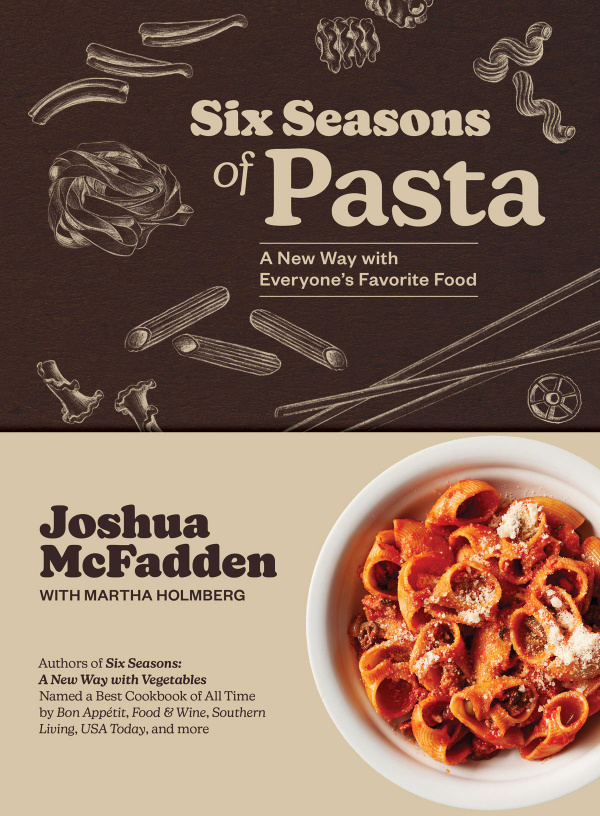


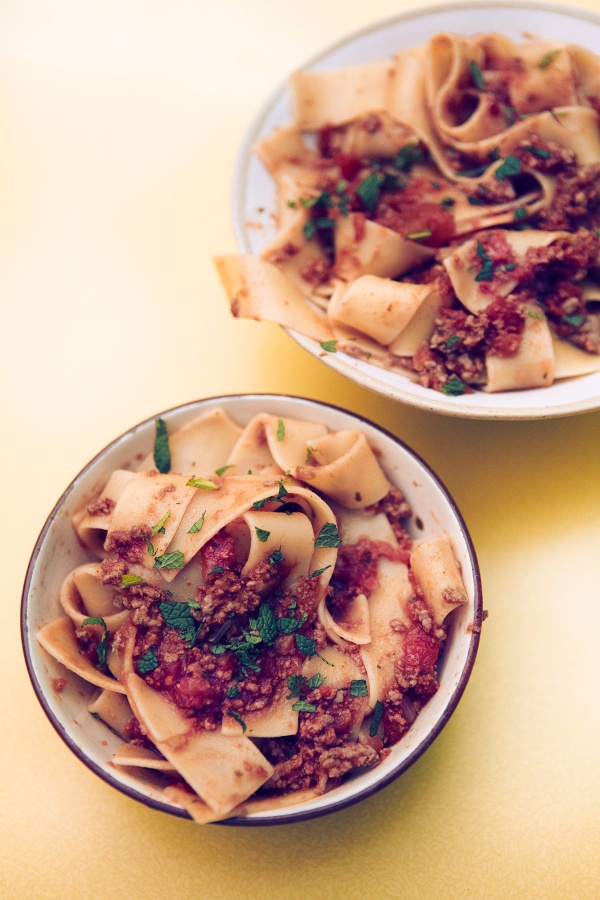
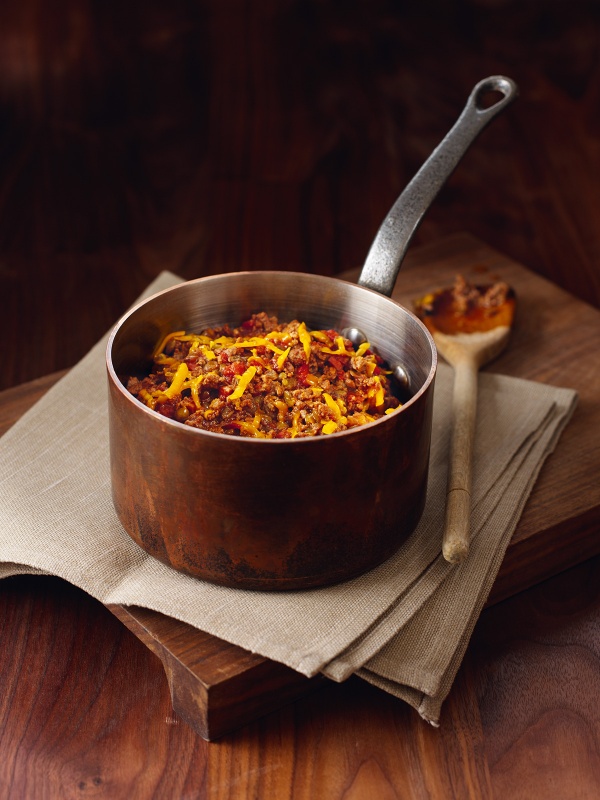
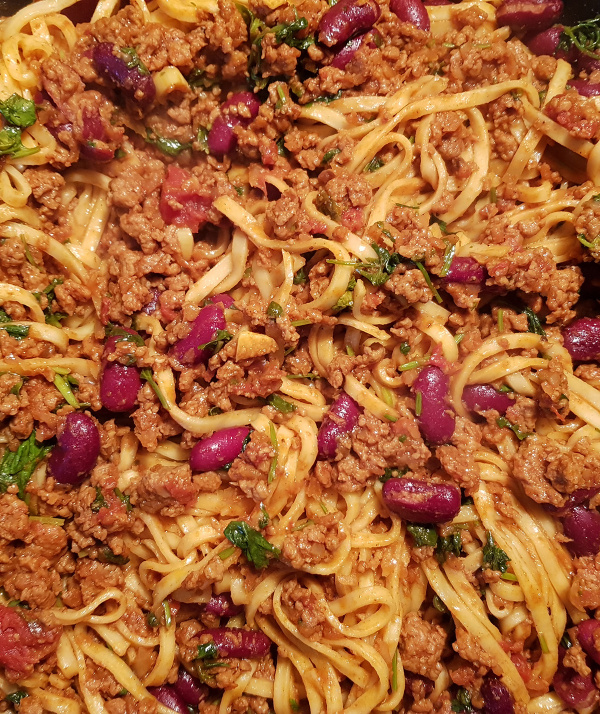
Tell us what you think
Thank you {% member.data['first-name'] %}.
Explore more recipesYour comment has been submitted.